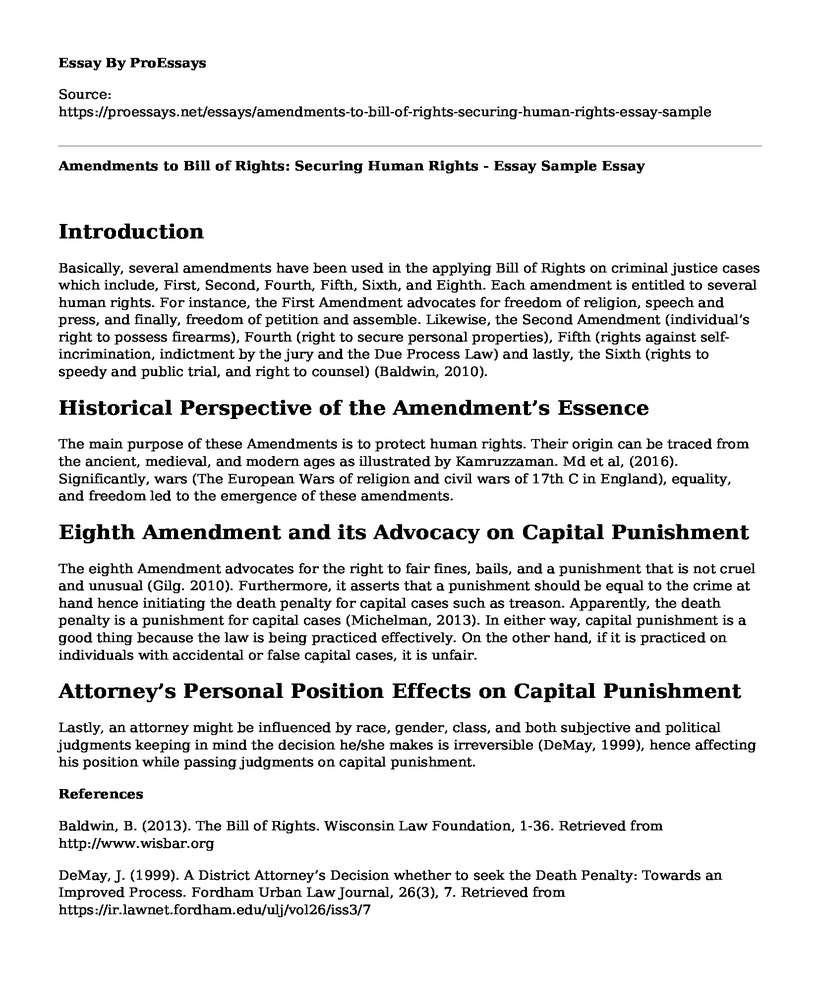Introduction
Basically, several amendments have been used in the applying Bill of Rights on criminal justice cases which include, First, Second, Fourth, Fifth, Sixth, and Eighth. Each amendment is entitled to several human rights. For instance, the First Amendment advocates for freedom of religion, speech and press, and finally, freedom of petition and assemble. Likewise, the Second Amendment (individual’s right to possess firearms), Fourth (right to secure personal properties), Fifth (rights against self-incrimination, indictment by the jury and the Due Process Law) and lastly, the Sixth (rights to speedy and public trial, and right to counsel) (Baldwin, 2010).
Historical Perspective of the Amendment’s Essence
The main purpose of these Amendments is to protect human rights. Their origin can be traced from the ancient, medieval, and modern ages as illustrated by Kamruzzaman. Md et al, (2016). Significantly, wars (The European Wars of religion and civil wars of 17th C in England), equality, and freedom led to the emergence of these amendments.
Eighth Amendment and its Advocacy on Capital Punishment
The eighth Amendment advocates for the right to fair fines, bails, and a punishment that is not cruel and unusual (Gilg. 2010). Furthermore, it asserts that a punishment should be equal to the crime at hand hence initiating the death penalty for capital cases such as treason. Apparently, the death penalty is a punishment for capital cases (Michelman, 2013). In either way, capital punishment is a good thing because the law is being practiced effectively. On the other hand, if it is practiced on individuals with accidental or false capital cases, it is unfair.
Attorney’s Personal Position Effects on Capital Punishment
Lastly, an attorney might be influenced by race, gender, class, and both subjective and political judgments keeping in mind the decision he/she makes is irreversible (DeMay, 1999), hence affecting his position while passing judgments on capital punishment.
References
Baldwin, B. (2013). The Bill of Rights. Wisconsin Law Foundation, 1-36. Retrieved from http://www.wisbar.org
DeMay, J. (1999). A District Attorney’s Decision whether to seek the Death Penalty: Towards an Improved Process. Fordham Urban Law Journal, 26(3), 7. Retrieved from https://ir.lawnet.fordham.edu/ulj/vol26/iss3/7
Gilg, R. (2010). Know your Rights. A Guide to the United States Constitution, 1-31. Retrieved from http://www.justice.gov
Kamruzzaman, Md., & Das. K. (2016). The Evaluation of Human Rights: An Overview in Historical Perspective. American Journal of Service Science and Management, 3(2), 5-12. Retrieved from http://www.openscienceonline.com/journal/ajssm
Michelman, I. F. (2013). The Bill Of Rights, the Common Law, and the Freedom-Friendly State. University of Miami Law Review, 58(1), 22. Retrieved from http://repository.law.miami.edu/umlr
Ricotta, J. D. (1998). Eighth Amendment--The Death Penalty for Juveniles: A State's Right or a Child's Injustice, 79, 1-33. Retrieved from https://scholarlycommons.law.northwestern.edu/jclc
Cite this page
Amendments to Bill of Rights: Securing Human Rights - Essay Sample. (2023, Aug 21). Retrieved from https://proessays.net/essays/amendments-to-bill-of-rights-securing-human-rights-essay-sample
If you are the original author of this essay and no longer wish to have it published on the ProEssays website, please click below to request its removal:
- Ethical Hacking as a Means of Improving Cybersecurity
- Books About Criminal Justice
- War on Terrorism and Human Rights Essay Example
- Research Paper on Legal Issues in Correction
- Paper Example on Canada: A Model of Stability and Rule of Law
- Essay Sample on Juvenile Justice: Processes, Screening, & Diversion
- Essay Sample on Informed Consent: A Challenge for Decisionally Impaired Individuals







